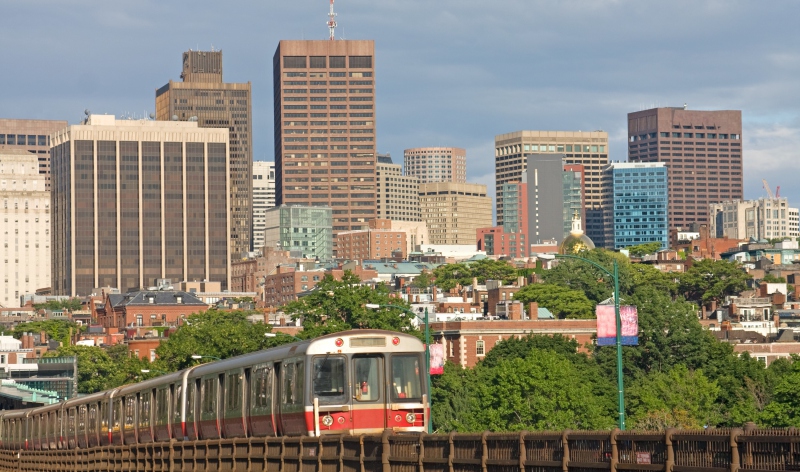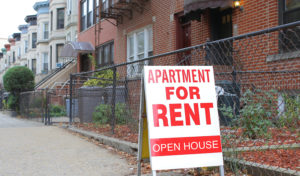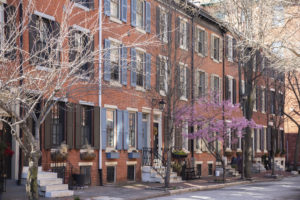
Scholars argue for “upzoning” to build more multi-family homes on land near transit stations.
Over the past decade, housing costs have increased in many of America’s wealthy cities and suburbs. Housing development has not. Without affordable housing, many low- or middle-income households cannot afford to live and work in economically vibrant, high-opportunity areas.
In a recent report for the Brookings Institution, Sarah Crump and three coauthors argue that the housing affordability crisis stems from zoning restrictions that prevent developing new housing in affluent areas. They focus on the greater Boston area, arguing that Massachusetts lawmakers should impose a statewide policy legalizing development near transit stations to create affordable housing.
Land near transit stations is typically expensive, leading economists to expect that it could be used for high-density housing. In many Boston suburbs, single-family detached homes occupy the expensive land surrounding transit stations. The median single-family home near commuter rail stations sits on a one-third acre lot, an inefficient use of high-value real estate, according to Crump and her coauthors. They argue that the inefficient use of high-value property is not a market outcome—it results from zoning regulations.
Zoning regulations can limit housing development. These regulations include minimum lot size requirements, development growth caps, and prohibiting irregularly shaped lots. To counter restrictions on development, Crump and her coauthors recommend “upzoning”—changing the zoning code to allow for denser buildings, including multi-family homes such as duplexes, attached townhouses, or condo buildings.
Many of Boston’s affluent suburbs have adopted zoning restrictions that prevent any additional housing. Upzoning here would replace single-family homes with multi-family homes in communities that lack active housing development. As many suburbs restrict zoning and impose barriers to development, the Crump team argues that a statewide policy requiring local ordinances to upzone could lead to more affordable housing opportunities. Local officials typically govern zoning laws, but an increasing number of states have intervened when restrictive local zoning regulations have contributed to housing shortages.
Crump and her coauthors estimate that redeveloping single-family homes within a half mile of transit stations into multi-family buildings could create 200 to 600 new housing options in the next five years.
The Crump team argues that upzoning to permit building several homes on a single lot—particularly on expensive land—reduces the cost of each home. For example, in the costly land near the Wellesley Hills station outside of Boston, the land for an average single-family home costs about $850,000. Construction for the new home brings the total cost to about $2 million. If that same land were instead used for a low-rise condo building with 11 units, the cost per family would drop to $500,000.
Offering multi-family homes has the greatest impact in the most expensive areas. In towns such as Wellesley, permitting new construction could allow a family to buy a new condo for almost half the price of the median existing home. Affordable multi-unit housing could give moderate-income families entry into previously inaccessible communities and provide wealthy communities with a more diverse labor market.
Zoning code changes to encourage development do not usually produce affordable housing in areas with lower cost homes and may even have a detrimental effect. For example, development in moderate-and low-income communities around Boston increased average housing prices. This type of development, often termed “gentrification,” can push racial and economic diversity out of areas as prices rise to a level that only wealthier, overwhelmingly white, families can afford.
Crump and her coauthors emphasize that changing zoning laws to create affordable housing for moderate-income families captures just one part of the greater Boston housing affordability problem. A second part lies in low-income households’ inability to afford existing market-rate housing. Crump and her coauthors only sought to increase the affordable housing supply but they claim that their proposed policy can help low-income families pay for housing as well.
Some low-income families receive vouchers from the U.S. Department of Housing and Urban Development (HUD) that can subsidize rent in moderate- and high-income neighborhoods. HUD intends for these vouchers to help low-income families move into higher-opportunity areas, but affluent cities such as Wellesley often lack rental properties. Constructing multi-family homes in affluent suburbs could provide more rental spaces for low-income families.
In addition, allowing high-density development in affluent areas could shift the current development of new housing from low- and moderate-income communities to affluent communities. Crump and her coauthors argue that statewide upzoning “is one of the most effective ways to reduce the risk of gentrification and displacement in lower-income Black and Latino or Hispanic communities.”
Crump and her coauthors stress that, although statewide upzoning alone cannot solve the housing crisis, Massachusetts policymakers can promote affordable housing by addressing zoning regulations that have long prevented building more affordable housing in affluent areas.



